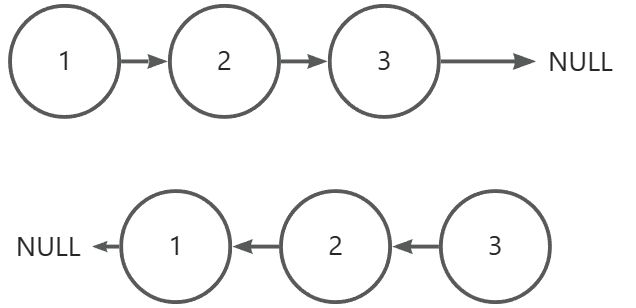鏈表就是將所有數據都用一個鏈子串起來,其中鏈表也有多種形式,包含單向鏈表、雙向鏈表等;
現在畢竟還是基礎階段,就先學習單鏈表吧;
鏈表用頭結點head表示一整個鏈表,每個鏈表的節點包含當前節點的值val和下一個節點next。
鏈表的好處就是刪除和插入比較容易,不需要移動其他元素。只需要改變下一個節點的指向值即可。
第一題 面試題 02.02. 返回倒數第 k 個節點
https://leetcode.cn/problems/kth-node-from-end-of-list-lcci/description/
返回第k個節點的值,這里使用雙指針的思路,定義一個快指針和慢指針,兩個指針之間間隔k位,快指針移動到最后一個節點的下一個節點(即節點為空時)時就停止,此時慢指針對應的就是倒數第k個節點值。
/*** Definition for singly-linked list.* struct ListNode {* int val;* struct ListNode *next;* };*/int kthToLast(struct ListNode* head, int k){struct ListNode * fast = head;struct ListNode * slow = head;for(int i = 0; i < k; ++i) {fast = fast->next;}while(fast) {fast = fast->next;slow = slow->next;}return slow->val;
}
第二題 19. 刪除鏈表的倒數第 N 個結點
https://leetcode.cn/problems/remove-nth-node-from-end-of-list/description/
刪除倒數第n個節點,思路和上一題一樣,先找到倒數第N個節點,我們要刪除這個節點,所以需要找到這個節點的前一個節點N+1;
直接將下一個值指向N的下一個值即可。
/*** Definition for singly-linked list.* struct ListNode {* int val;* struct ListNode *next;* };*/
struct ListNode* removeNthFromEnd(struct ListNode* head, int n) {struct ListNode * fast = head;struct ListNode * slow = head;for(int i = 0; i < n; ++i) {fast = fast->next;if(fast == NULL) {return head->next;}}fast = fast->next;while(fast) {fast = fast->next;slow = slow->next;}slow->next = slow->next->next;return head;}
第三題 206. 反轉鏈表
https://leetcode.cn/problems/reverse-linked-list/description/
第一種:迭代方法,定義一個當前節點cur和前一個節點pre,遍歷鏈表,將指向換一下方向即可,注意保存cur->next

/*** Definition for singly-linked list.* struct ListNode {* int val;* struct ListNode *next;* };*/
struct ListNode* reverseList(struct ListNode* head) {struct ListNode * pre = NULL;struct ListNode * cur = head;while(cur) {struct ListNode * temp = cur->next;cur->next = pre;pre = cur;cur = temp;}return pre;
}
第二種:遞歸
主要思想就是從最后一個開始,將它的指針指向前一個節點,然后前一個節點指向NULL;
這時又遞歸到前一個節點,和上面操作一樣,一直到第一個頭結點,這時頭結點會置為NULL;
/*** Definition for singly-linked list.* struct ListNode {* int val;* struct ListNode *next;* };*/struct ListNode * doReverse(struct ListNode * head, struct ListNode ** outHead) {遞歸臨界點,如果到最后一個節點則開始往回走;if(head == NULL || head->next == NULL) {*outHead = head; outhead是最終翻轉后的頭結點,所以這里head最后一個節點就是outhead的頭結點return head;}
每次遞歸都向下一層,返回值為反轉后的struct ListNode * tail = doReverse(head->next, outHead);tail->next = head;head->next = NULL;return head;
}struct ListNode* reverseList(struct ListNode* head) {struct ListNode * outHead;doReverse(head, &outHead);return outHead;
}
第四題 237. 刪除鏈表中的節點
https://leetcode.cn/problems/delete-node-in-a-linked-list/description/
這道題代碼不難,主要的是思想,能不能想到這樣的方法。
只給了一個需要刪除的節點node,讓你刪除這個節點。
那么我們只需要將node->next的值賦值給node,那么這樣就可以刪除node->next,這樣同樣可以達到需要的結果。
/*** Definition for singly-linked list.* struct ListNode {* int val;* struct ListNode *next;* };*/
void deleteNode(struct ListNode* node) {node->val = node->next->val;node->next = node->next->next;
}
第五題 24. 兩兩交換鏈表中的節點
https://leetcode.cn/problems/swap-nodes-in-pairs/description/
本題有兩種做法,迭代和遞歸,遞歸相對來說難理解。
一、遞歸
/*** Definition for singly-linked list.* struct ListNode {* int val;* struct ListNode *next;* };*/
struct ListNode* swapPairs(struct ListNode* head) {定義臨界點,即遞到最后一個節點或者空時開始歸。if(head == NULL || head->next == NULL) {return head;}這里就是記錄遞歸的當前節點和下一個節點,用于后續交換struct ListNode* now = head;struct ListNode* next = head->next;這里記錄的是后面已經完成交換的頭結點nextnext;struct ListNode* nextnext = swapPairs(now->next->next);這里算是核心,now->next = nextnext; 每次將當前節點的下個節點指向已經完成交換的頭結點next->next = now; 將當前節點下一個節點又指向當前節點,即完成本輪交換return next;
}
二、迭代
/*** Definition for singly-linked list.* struct ListNode {* int val;* ListNode *next;* ListNode() : val(0), next(nullptr) {}* ListNode(int x) : val(x), next(nullptr) {}* ListNode(int x, ListNode *next) : val(x), next(next) {}* };*/
class Solution {
public:ListNode* swapPairs(ListNode* head) {ListNode * virhead = new ListNode();virhead->next = head;ListNode * cur = virhead;while (cur->next != nullptr && cur->next->next != nullptr) {ListNode * temp1 = cur->next;ListNode * temp2 = cur->next->next->next;cur->next = cur->next->next;cur->next->next = temp1;cur->next->next->next = temp2;cur = cur->next->next;}return virhead->next;}
};


單片機開發筆記(6): 呼吸燈)





Java 基礎語法)
User-Managed Incomplete Recovery)
)

開發板的Android10的SDK)

)

(查看開頭、從開頭查看、從起始查看、反向導航、反向查找))


